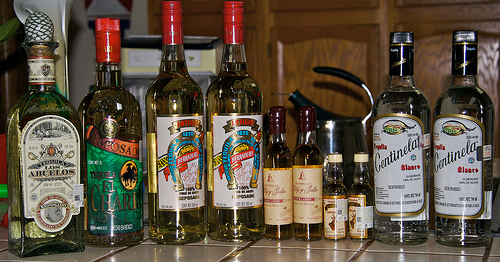Tell Me About Tequila!

Tequila holds a fearsome reputation in the hearts, and livers, of many social drinkers. But what does the average Briton really know about this famous drink, which has a sadly unsavoury reputation over here? When I began researching this article, my only experience of tequila had been at the culmination of an evening out, taken as a shot with salt and a slice of lemon. I knew there was a worm involved somewhere along the line as well, and that it is sometimes used to give cocktails a bit of zing, but that was about it. But there’s a lot more to tequila than that, as I shall now explain.

Tequila is fermented from the blue agave plant, which is grown in the volcanic soil around the town of Tequila, in the state of Jalisco, Mexico. Strictly-speaking, only the spirit from this area can be truly called Tequila, but a similar drink, Mescal, is made from other species of agave which are grown all around Mexico. Any bottle not labelled as 100% blue agave with no adulterations is known as a “mixto”. Tequila, the town, is a national heritage site. There is a Tequila museum there, and visitors can enjoy tequila-tasting, as well as take a trip to the volcano around which the blue agave plant grows. In a similar fashion to the wine-train in the Napa Valley region of California, a popular train journey runs through the fields of Tequila-country, stopping at the town’s main distillery.
Over here, most people drink tequila in the form of a shot, sometimes with a lick of salt beforehand and a chewing on a slice of lemon afterwards to aid digestion. In Mexico though it’s normally drunk straight, and in small sips to savour the taste rather than all in one go. They refer to the salt-and-lemon technique as “training wheels.”
Tequila is commonly added to cocktails. No doubt you’ll have heard of some of the most popular, such as the Margarita, which typically comes in a glass with a salt-lined rim, salt being perceived as taking the edge off the burn, and the Tequila Sunrise, a real holiday tipple.
If you want to try something a bit different, a traditional Mexican concoction is the bandera – a glass of lime, a glass of tequila, and a glass of sagrita, representing the three colours of the Mexican flag.
Contrary to what I’d heard, the worm is actually a sign of contamination rather than a mark of quality. It’s actually mainly found in bottles of mescal, and is the larva of a moth that feeds on the agave. A lot of mescal distilleries are pretty basic and sometimes a larva slips through the production process. Although harmless, it certainly adds nothing to the taste. Despite that, finding and eating a “worm” has become something of a weird and unpleasant ritual.
People on Latin America tours will often encounter meals with tequila in them in restaurants and bars. It adds a unique twist to many dishes. Try adding it to the recipes to shrimp cocktail, chicken enchilada, even popcorn. Or just infuse slices of watermelon with the spirit for a refreshing alcoholic bite on a hot summer’s day.
It’s been argued that a few sips of tequila before and after a meal can be a digestive aid, and can even have a positive effect on the memory! Of course, as with any alcoholic drink, moderation is the motto. But experts say if you are drinking pure tequila, 100% blue agave stuff, then any hangovers should be far less severe. Bear in mind that in Mexico, tequila is a sophisticated drink, not something to be chucked down one’s throat in an attempt to get as far-gone as possible.
